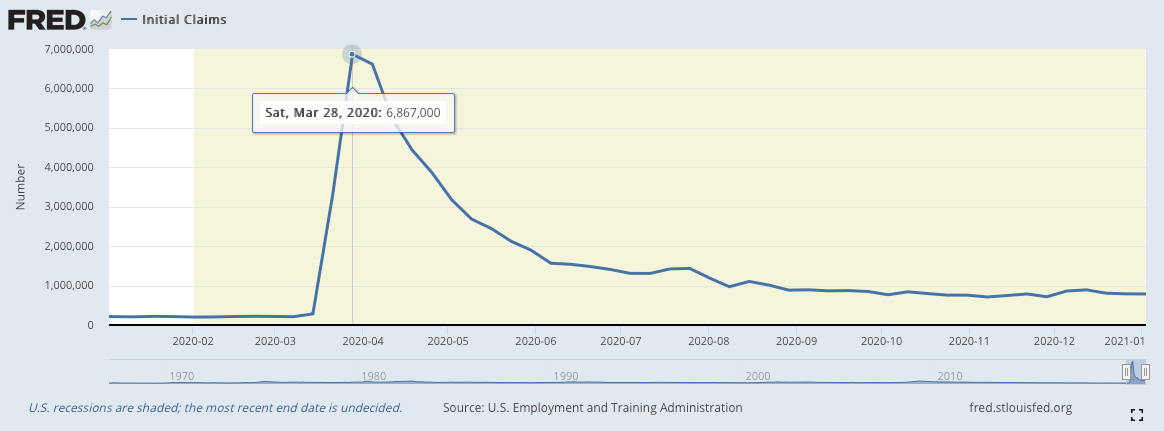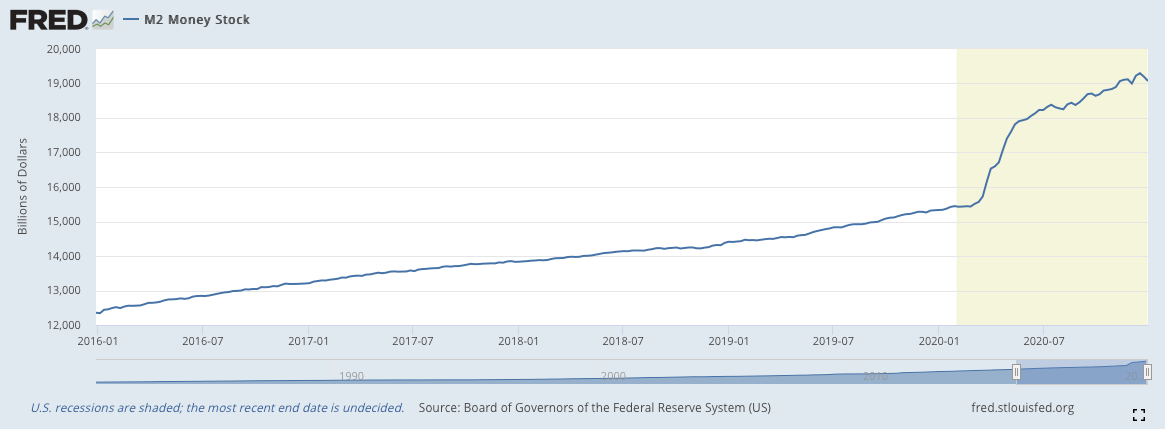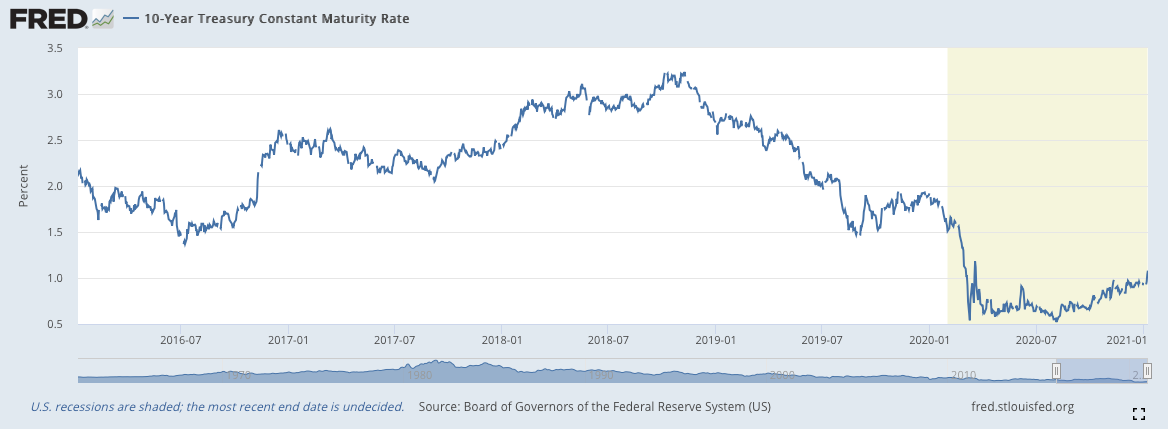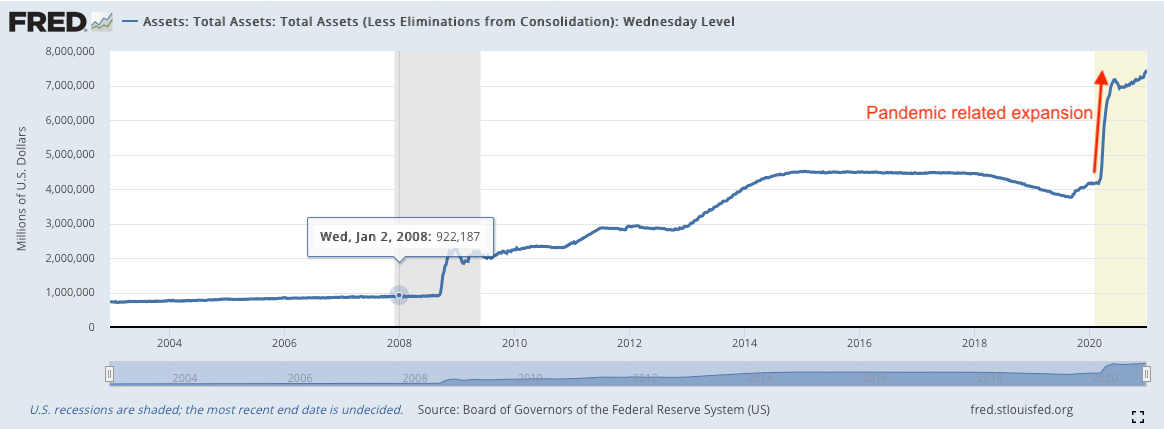U.S. Mergers and Acquisitions: A 2020 Report
2020 represented a year full of turmoil and despair for some and opportunity for others. While millions lost their jobs, the portion of the population that managed to stay employed saw their bank balances swell. The weekly unemployment claims chart provides a stark contrast to the M2 money supply chart below. M2 money supply consists of savings deposits, money market funds, CDs below $100,000 and M1 money stock.


Cheap money became cheaper. We had stimulus programs that rivaled anything we have seen before both in terms of speed of rollout and size. The chart of the 10 year treasury rate and the Fed’s balance sheet speak volumes.


While we did a lot wrong on the pandemic front, we did a lot right on the fiscal front. Yes, we will pay the price for all this stimulus in the years to come but we averted a complete disaster. Watching the bear market unfold during the Great Recession in 2008-2009, I was amazed by the resistance to the $700 billion TARP program. That program bailed out a lot of large companies but was instrumental in stabilizing a financial system on the brink of collapse. The fact that the TARP program eventually turned a profit for the government was just the cherry on the top. Oddly enough, there was no resistance to the stimulus programs this time around and not enough concern for either the Fed’s ballooning balance sheet or our growing budget deficit. According to the nonpartisan Congressional Budget Office,
“In fiscal year 2020, which ended on September 30, the federal budget deficit totaled $3.1 trillion—more than triple the shortfall recorded in fiscal year 2019.”
If anything we saw most lawmakers of both political persuasions clamor for even more stimulus. All this excess capital is triggering asset inflation across multiple areas including Bitcoin, commodities, issuances of special purpose acquisition companies (SPACs), IPO valuations, growth stocks and clean energy stocks. M&A was no stranger to this mania and this year of uncertainty ended with a bang with 27 deals announced last month.
Looking at the full year however, there were 154 deals worth over $605 billion announced in 2020, a sharp decline when compared to the $938 worth of deals announced in 2019 and over $1 trillion worth of deals announced in 2018. M&A activity slowed down significantly in the second quarter of the year due to the pandemic, with just eleven new deals announced during the full quarter. This was an 80% decline in the number of deals announced compared to the 56 deals that were announced in Q2 2019.
The most interesting aspect of the year was how wide the spreads were in March 2020. More than 10 deals had spreads of over 25% and 26 deals registered spreads of over 10% as discussed in our March 30 Merger Arbitrage Mondays post. Not all of these deals went on to close and as many as 12 failed as you can see from the infographic below put together by our analysts. A few, including Tiffany and the mall REIT Taubman Centers took their acquirers to court to force them to complete the deal when they attempted to walk away. Definitive merger agreements are not easy to walk away from, although the acquirers can attempt to renegotiate the deal lower as LVMH did with Tiffany and Simon Property Group (SPG) did with Taubman Centers.
The news was not all bad with three deals receiving superior offers. Folks who held on to stocks of busted deals like Frontyard Residential (RESI) and Pacific Biosciences (PACB) made out like bandits as discussed here. One of the more interesting situations last year were the Contingent Value Rights or CVRs associated with Bristol-Myer’s acquisition of Celgene. CVRs are potential future payments that can occur long after a merger is consummate based on certain predefined conditions or milestones being met. CVRs were referred to as “merger securities” by Joel Greenblatt in his book You Can Be A Stock Market Genius.
We discussed CVRs several times in the past including the CVRs associated with Allergan’s acquisition of Tobira Therapeutics, the CVRs associated with Bristol-Myers Squibb’s acquisition of Celgene and United Therapeutics’ acquisition of SteadyMed. The Celgene CVRs were particularly interesting because of their disproportionate payoff of $9/CVR. These CVRs were publicly tradable and at times were available for well below $1. They attracted a lot of interest among both retail and institutional investors. While I liked the disproportionate payoff, I was not too fond of the stringent milestones associated with the CVRs. I kept the CVRs from when the Celgene deal closed but decided not to buy more on the open market.
I have had good luck with CVRs such as those associated with the Tobira and Safeway deals. I wrote about two active deals recently that include a CVRs with a disproportionate payoff (almost $8 for every $1 invested) and another one where the CVR is a free lottery ticket if the deal closes. I think the probability of these CVRs paying out is a little higher than the Celgene CVRs because the milestones are more generous to shareholders.
Conclusion:
2020 was not a year to sit tight and required active management if you were focused on merger arbitrage. It is easy to fall into the fallacy that just staying the course was the best strategy because the view in the rear view mirror is very clear. As the crisis unfolded, there was a lot of uncertainty related to both the virus and the government response to the pandemic. We didn’t know enough about the virus, we didn’t even know if it was airborne, whether reinfection was possible, how long the lockdowns will remain in effect, whether Congress would agree on a large enough stimulus and if the stimulus would reach the right hands at the right time.
I remember feeling the same way in the fourth quarter of 2008 when pretty much everything froze and all asset classes started falling in unison. Inverse correlations be damned. Thankfully this time insiders pointed the way for me by buying more than they were selling for the first time in 10 years. This helped me start covering my hedges and start buying on the long side. As investors most of us came out of 2020 significantly ahead of where we started the year but the size of the current bubble has me very worried about 2021.

